Go slow with Gizzi Erskine's comforting stews, ragùs and one-pots
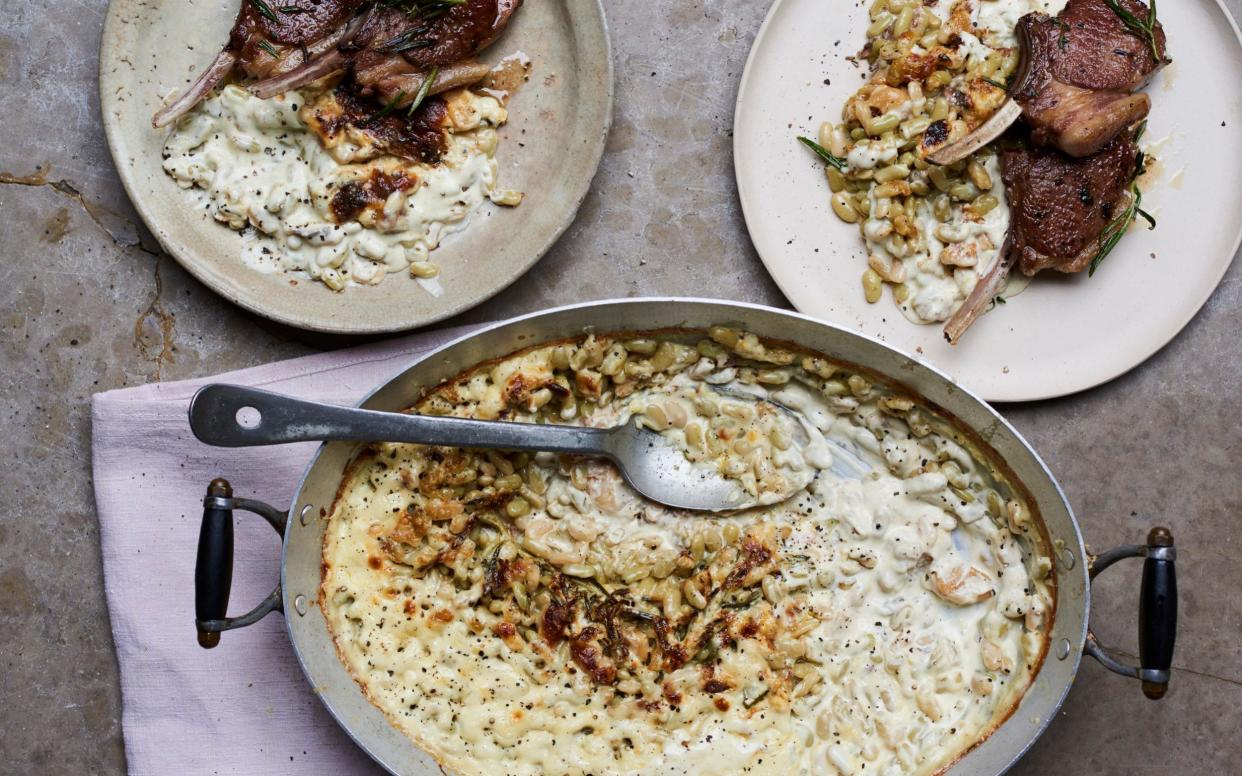
Recipes below:
Blonde ragù with pork, veal and sage
Boston beer baked beans
Beef and potato stew
Planet-friendly Bolognese
Flageolet, anchovy, rosemary and confit garlic gratin
Bangers, bacon and beans
Sometimes I feel out of sync with the modern approach to cooking, which seems to be all about valuing convenience over quality. Our obsession with ease and speed puts us in danger of failing to appreciate the joys of technique and process, and what it means to pour love and care into the food we grow and cook. Cooking shouldn’t just be about the final result, it should be about the whole experience.
The kick I get from cooking is the same now as when I started. The day I made my first stew is still etched in my memory: the anticipation of seeing a dish develop from raw whole ingredients, rolling my sleeves up and working out the right way to chop, brown, braise and bake them.
I trusted my mother’s advice as she dictated how things should be done, for she had done this a million times before. Her stews, all gelatinous and sticky, were the best I’d tasted. I wanted to learn to make stew because that was the food that meant family. Coming home to the smell of a stew cooking made me feel cosy. It made me feel safe. It still does.
I’m not living in a fantasy land where we all have time to spend hours cooking every day. But I guarantee that a Saturday afternoon investing in the perfect stew or ragù, or even just an evening a week when you park the troubles of the day and create nourishing soulful food, is attainable. So I hope to inspire you to get stuck in, enjoy the techniques, and evaluate the food you eat in order to positively influence your health, your soul and the world.
Blonde ragù with pork, veal and sage
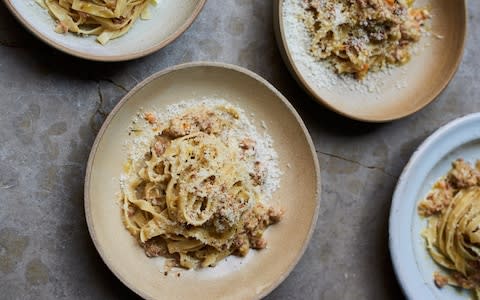
SERVES
Eight
INGREDIENTS
4 tbsp olive oil
2 tbsp butter
2 large onions, finely chopped
2 medium carrots, finely chopped
2 leeks, trimmed and finely chopped
2 celery sticks, finely chopped
6 cloves of garlic, finely chopped
400g pork mince
400g veal mince
200g piece of smoked bacon or pancetta, skinned, trimmed, chopped and minced in a food processor
3-4 bay leaves
3 sprigs of rosemary
Few sprigs of thyme
400ml dry white wine
1 pint whole milk
1 pint fresh chicken stock
300ml double cream
Zest of 2 lemons
Leaves of ½ small bunch of sage
½ nutmeg, grated
½ tsp black pepper, freshly ground
Parmesan, to serve
METHOD
Heat two tablespoons of the oil and one tablespoon of the butter in a large flameproof casserole. Add the onions, carrots, leeks, celery and garlic and cook over a very low heat for about 30 minutes, or until they have softened, lost all their water and are tinged with a golden hue.
Meanwhile heat a frying pan until very hot, add the rest of the oil and brown the pork and veal mince together with the bacon or pancetta in batches. Transfer the meat and any juices to the casserole.
Add the bay leaves, rosemary and thyme and then pour over the white wine. Bring to the boil and cook for five minutes, then pour over the milk and stock. When the liquid comes to the boil, lower the heat and partially cover the casserole with a lid. Cook gently for two hours.
The sauce is ready when the meat is cooked and the sauce reduced and super-rich. Pour over the cream and add the lemon zest, sage leaves and nutmeg and give everything a good stir.
Let this cook for a further five minutes to reduce a little and take on these last flavours. In the meantime cook your pasta. Season the sauce and then pour a couple of ladlefuls over each portion of pasta and serve with parmesan and lots of black pepper.
Boston beer baked beans
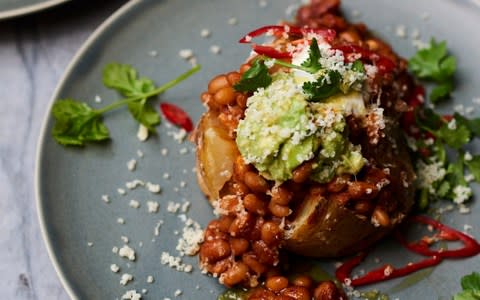
You can eat these with a fry-up if you like, but they should really take centre stage. I love them stuffed into a jacket potato and topped with grated cheese, guacamole, sour cream, pico de gallo, jalapeños and fresh coriander.
SERVES
Four
INGREDIENTS
300g dried white haricot beans
2 tbsp rapeseed oil
2 onions, finely chopped
1 garlic bulb, halved
300ml passata
250ml white wine
250ml Boston beer
500ml fresh gelatinous chicken or vegetable stock
2 tbsp soft brown sugar
2 tbsp sherry, red wine or cider vinegar
1 tsp black treacle
1 tbsp English mustard
1 tbsp cumin seeds, toasted
Few sprigs of thyme
Good pinch of cloves
METHOD
Soak the beans overnight in plenty of cold water. The next day, drain and rinse the beans and put them in a heavy, ovenproof casserole and add fresh water to come about 10cm above the beans. Bring to the boil and cook for 10-15 minutes, then turn the heat down to a simmer for about an hour until the beans are tender but not completely soft. Drain and leave to one side.
Heat the oil in a medium casserole and slowly brown the onions for 10 to 15 minutes. Add the halved garlic, cut side down, for the last minute of cooking so it starts to caramelise. Next add the passata, white wine, beer and stock and bring to the boil. Mix in the sugar, vinegar, treacle, mustard, cumin seeds, thyme, cloves and some black pepper. Simmer for 30 minutes. It will be a pretty loose sauce, but fear not; it will have a few more hours cooking in the oven with the beans.
Preheat the oven to 150C/130C fan/Gas 2. Blitz the sauce in a blender for a minute, or until super- smooth. Wash out the casserole and put the beans and sauce back in. Put on the lid and bake in the oven for three hours. The beans should be cooked through and the sauce should coat them, with some slight charring on the edge.
If the sauce is too thin, reduce on the hob with the lid off until it is thickened and full of flavour. Season with salt and pepper and you’re ready to serve.
Beef and potato stew
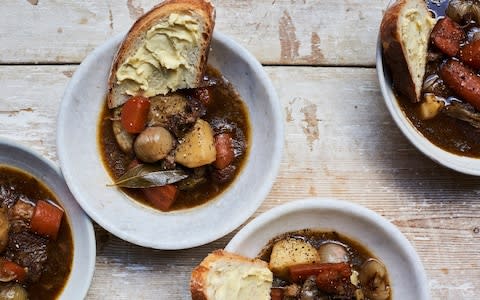
When making a stew, I always favour ox cheek, oxtail or featherblade because they cook into juicy, falling-apart meat and a delicious mouth-sticking braise.
SERVES
Four
INGREDIENTS
Olive or rapeseed oil or ghee, for frying
2 ox cheeks (roughly 900g), each cut into 6 pieces
10 small onions or shallots, peeled but left whole
1 bay leaf
2 sprigs of rosemary
A few sprigs of thyme
2 carrots, halved lengthways and cut into 6cm pieces
1 tbsp plain flour
500ml fresh beef stock
1 leek, cut into 4 long sections
400g potatoes, peeled and cut into chunks
A handful of parsley, chopped
Sea salt and freshly ground black pepper
METHOD
Heat a frying pan and put in one tablespoon of your chosen fat. Season the ox cheek pieces well with salt and pepper and brown them in batches. Remove them from the pan once nicely caramelised and set aside.
In a heavy-based casserole, heat another couple of tablespoons of fat and throw in the onions and the bay leaf, rosemary and thyme. Allow to cook for five minutes over a higher heat than normal, until the onions start to soften and caramelise a little at the edges. Next add the carrots and cook for a couple more minutes, stirring regularly.
Stir in the flour and cook for a couple of minutes. Add the stock and the leeks, followed by the ox cheeks and their residual juices. If necessary top up the casserole with water so that everything is just covered with liquid. Bring to the boil, then simmer and cover.
Cook gently for two-and-a-half hours. Add the potatoes, stir gently, replace the lid and cook for a further 40 minutes until the potatoes are cooked through and the meat gives way. Check the seasoning and stir in the parsley.
Turn off the heat and leave the stew to rest with the lid on for 10 minutes before serving with crusty bread and butter – or double up on potatoes and serve with creamy mash.
Planet-friendly bolognese
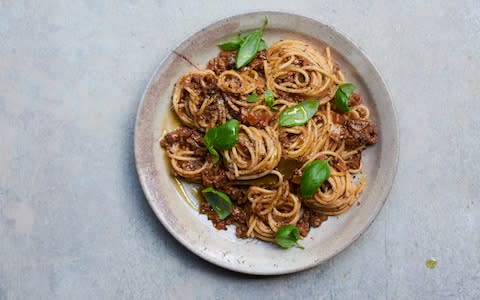
This vegan spag bol has been niftily made, carefully building layers of flavour so that even the most hardened meat eaters won’t feel that they’re missing out. This makes stacks and freezes brilliantly, so it’s a perfect batch-cook recipe.
SERVES
15
INGREDIENTS
1 x 50g packet dried porcini mushrooms
1 x 50g packet dried shiitake mushrooms
Olive oil, for frying
2 large onions, finely chopped
2 carrots, finely chopped
2 celery sticks, finely chopped
2 leeks, finely chopped
1 head of garlic, cloves finely chopped
2 tsp tomato purée
300ml white wine
400ml red wine (or wine of any colour)
2kg fresh tomatoes, blitzed into a purée
120g fresh shiitake mushrooms, roughly chopped
300g portobello mushrooms, roughly chopped
250g chestnut mushrooms, roughly chopped
1 x 500g packet frozen soy mince, defrosted
300g smoked tofu, whizzed in a blender
2 tbsp white miso paste
1 tsp Marmite
1 tbsp nutritional yeast flakes
3 sprigs of rosemary
6 or 7 sprigs of thyme
3 bay leaves
500ml vegetable stock
½ tsp celery salt
½ nutmeg, grated
Basil leaves, to serve
METHOD
First rehydrate the dried mushrooms. Empty both packets into a small bowl and cover with one litre of boiling water. Place a smaller bowl on top and leave for 20 minutes while you chop up your vegetables. When rehydrated, chop the mushrooms to resemble mince and reserve the water.
Heat a decent slug of olive oil in a large flameproof casserole (I use a Le Creuset casserole 30cm wide), then put the onions, carrots, celery and leeks into the pan and sweat them slowly for about 20 minutes, stirring every so often. Add the garlic for the last few minutes to soften. Ramp up the heat and add the tomato purée. Cover all the veg in the purée and start to caramelise the edges of the vegetables. This takes about five to 10 minutes.
Pour in the wine and cook for 10 minutes. Add the blitzed tomatoes, lower the heat and let the sauce cook for 15 minutes while you prepare the rest.
In another pan fry the mushrooms, the soy mince and tofu, together with the rehydrated mushrooms. Just as when you cook meat, you want a dark golden caramelisation over the outside of the mushrooms and soy, and to get that you will have to fry in batches. I did it in five or six. When each batch is caramelised, transfer to a plate.
Add the caramelised soy, tofu and mushrooms to the tomato sauce, with the miso, Marmite, yeast, herbs, reserved porcini water and vegetable stock and leave to braise with the lid off for one hour. Stir and scrape the bottom every so often to prevent the sauce catching.
After an hour it should be rich, well reduced and full of flavour. Season with the salts, pepper and nutmeg and then you’re ready to cook your pasta. I usually cook about 90g pasta per person, and reduce the cooking time by a minute or two.
Finish the dish by mixing the sauce with the pasta over a medium heat, which completes the cooking of the pasta and binds everything together nicely. I suggest about two ladles of sauce per person. Scatter over basil leaves to serve.
Flageolet, anchovy, rosemary and confit garlic gratin
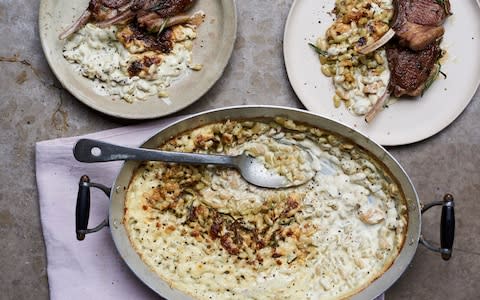
Have this with roast lamb at the weekend or even with pink lamb cutlets or chops in the week.
SERVES
Six as a side, or four as a main
INGREDIENTS
For the confit garlic
1 head of garlic, tops sliced off
Enough good-quality olive oil to just cover the garlic in a small pan
For the gratin
350g dried flageolet beans, soaked overnight (or 800g cooked flageolet beans, drained)
1 head of confit garlic
4 tbsp garlic oil (from cooking the confit garlic)
300ml cream
A splash of whole milk
8 anchovy fillets
Salt and white pepper
A good grating of nutmeg
2 sprigs of rosemary
40g Gruyère cheese, grated
METHOD
To make the confit garlic, put the head of garlic into a small saucepan and pour over the olive oil until the garlic is just submerged.
Heat over the lowest flame, as it’s very important that the garlic doesn’t burn or the whole thing will turn acrid. Allow the garlic to very slowly cook in the oil for about 20 to 30 minutes until it is soft and buttery. You do not want it to boil. And you do not want any colour on the cloves.
To cook the flageolets, place the soaked beans in a large saucepan with plenty of unsalted water. Bring to the boil and cook for 30 to 45 minutes. Check regularly. They should have some bite but be completely cooked through. Flageolets can cook quite quickly, so make sure you keep watch. Drain and leave to steam in a sieve for 10 minutes.
Preheat the oven to 220C/200C fan/Gas 7. Spread the beans neatly in a large, shallow 25cm oval gratin dish. In another bowl, mix together the garlic oil, cream, milk, anchovies, pepper, salt and nutmeg. Check the seasoning.
Lay the rosemary sprigs across the beans (the flavour will infuse the gratin), pour over the creamy mixture and level out. The beans should be generously suspended in the sauce.
Sprinkle the cheese over the top and put in the oven for 15 minutes until the cheese has melted and gone a charred golden brown.
Bangers, bacon and beans
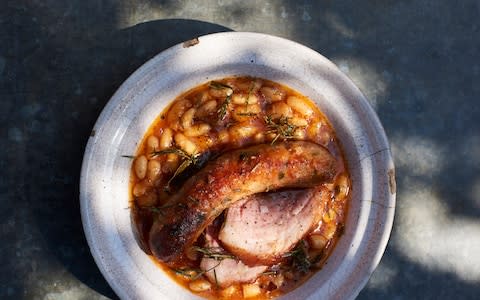
Toulouse sausages work best, but other sausages will do. You do need a thick slice of smoked bacon, so pop to your butcher.
SERVES
Four
INGREDIENTS
4 tbsp olive oil
2 onions, finely chopped
4 garlic cloves, finely chopped
A pinch of dried chilli
2 sprigs of rosemary
Few sprigs of thyme, leaves picked
2 bay leaves
4 tomatoes
300ml white wine
700ml chicken stock
300g cannellini beans, soaked overnight
4 Toulouse sausages
1 x 400g slice of smoked streaky bacon (about 2.5cm)
Juice and zest of ½ lemon
Large handful of parsley, chopped
Salt and pepper
METHOD
Preheat the oven to 180C/160C fan/Gas 4. In a medium flameproof casserole, heat two tablespoons of the oil and add the onions. Sweat the onions over a medium heat for 15 minutes until they turn golden. Add the garlic, chilli and herbs and cook for a couple more minutes.
Blitz your tomatoes into a smooth purée in a food processor and add to the onions and garlic. Allow to reduce down before adding the wine. Let this bubble for a couple of minutes and then add the stock. Cook this out slowly for an hour, blitz, and then add in the beans.
While the base of the sauce is coming along, brown your sausages. Heat the rest of the oil in a frying pan over a high heat, add the sausages and brown until they are a good colour on all sides (this usually takes eight to 10 minutes).
Transfer the sausages to the casserole. Return the frying pan to the heat and brown the bacon slice on all sides, again making sure it has a good colour all over.
Tuck the bacon in with the rest of the stew. Season well with salt and pepper, cover with a lid and place in the oven for an hour and 30 minutes. After this time remove the lid and return to the oven for a further 30 minutes to reduce the sauce a little.
Finally, before serving remove the sausages and stir through the lemon juice, zest and parsley. Return the sausages to the casserole. Check for seasoning; beans need a lot of salt and I like to make it quite peppery. Serve straight away, cutting the bacon slice into pieces and sharing them out equally.
Recipes taken from Slow by Gizzi Erskine (HQ, £25)

